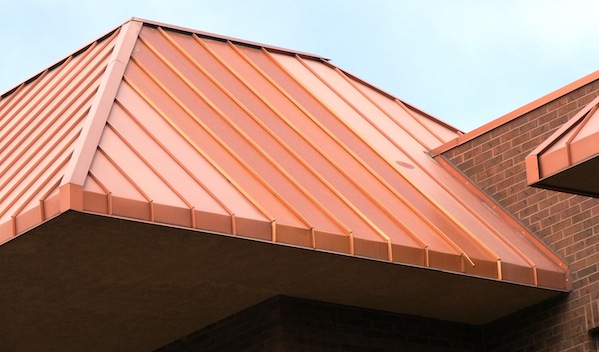Mastering Roof Inspections: Metal Roofs, Part 3
by Kenton Shepard and Nick Gromicko, CMI®
The purpose of the series “Mastering Roof Inspections” is to teach home inspectors, as well as insurance and roofing professionals, how to recognize proper and improper conditions while inspecting steep-slope, residential roofs. This series covers roof framing, roofing materials, the attic, and the conditions that affect the roofing materials and components, including wind and hail.
Naturally Weathering
Some types of metals are naturally resistant to corrosion and can be left exposed to weather with a minimum of protection from corrosion. Copper and aluminum are the most common.
Copper
Copper is very durable, lasting up to 100 years, and it’s fairly expensive. You’ll see it used most often on high-end homes and commercial buildings as panels and flashing, and sometimes as shingles.
Although it’s copper-colored right after it’s installed, it begins to oxidize immediately, going through a series of color changes, turning first to brown and eventually stabilizing as green.

This chart shows the general time frame of color changes, but actual times will vary with location. Runoff from the green patina it develops, called verdigris, will stain painted surfaces, masonry and other metals. Verdigris actually forms a protective barrier coating which helps give copper its long service life. Copper is one of the more noble metals and will corrode most other metals with which it’s likely to come into contact.
You will identify copper by its color. If you’re not sure, you can find an inconspicuous spot to scratch. The scratch should be copper-colored.
Aluminum
Aluminum also has a long service life and will not corrode by itself, so it’s a good choice for coastal and other high-corrosion climates, but it is subject to galvanic corrosion when it’s in contact with other metals in the presence of moisture.
You’ll see it in a lot of different styles because it’s so easily formed. It is ductile. Remember that term from the articles on asphalt shingles? That means that it’s soft and easily shaped. In fact, the folds and ridges created by heavy forming actually add strength to aluminum roofing.
Almost all modern aluminum roofing is pre-painted. Technology for new coatings allows steel and aluminum roofing to be manufactured to resemble both...

…new copper…

...and weathered copper, so don’t be too quick to call a roof copper in your report.
Although aluminum is extremely energy-intensive to produce, aluminum roofing has a recycled content of 90% to 95%, most of it from post-consumer beverage cans, so it’s actually a very energy-efficient and environmentally friendly product.
Advantages of Aluminum
The advantages of aluminum include its:
- resistance to corrosion;
- strength;
- light weight (it weighs less than 100 pounds per square); and
- availability in many styles.
The disadvantages are:
- it's more expensive to produce than steel; and
- it’s less hail-resistant than steel.
Learn how to master a roof inspection from beginning to end by reading the entire InterNACHI series: Mastering Roof Inspections.
Take InterNACHI’s free, online Roofing Inspection Course
Mastering Roof Inspections
Roofing Underlayment Types
Inspecting Underlayment on Roofs
Fall-Arrest Systems
Roofing (consumer-targeted)
More inspection articles like this

